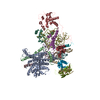Entry Database : PDB / ID : 6k3fTitle Crystal Structure of beta-Arrestin 2 in Complex with CXCR7 Phosphopeptide Beta-arrestin-2 Peptide from Atypical chemokine receptor 3 Keywords / Function / homology Function Domain/homology Component
/ / / / / / / / / / / / / / / / / / / / / / / / / / / / / / / / / / / / / / / / / / / / / / / / / / / / / / / / / / / / / / / / / / / / / / / / / / / / / / / / / / / / / / / / / / / / / / / / / / / / / / / / / / / / / / / / / / / / / / / / / / / / / / / / / / / / / / Biological species Rattus norvegicus (Norway rat)Homo sapiens (human)Method / / / Resolution : 2.3 Å Authors Min, K.J. / Yoon, H.J. / Lee, H.H. Funding support Organization Grant number Country National Research Foundation (NRF, Korea) 2015R1A5A1008958 National Research Foundation (NRF, Korea) 2018R1A2B2008142 Ministry of Science, ICT and Future Planning (MSIP) 2014M1A8A1049296
Journal : Structure / Year : 2020Title : Crystal Structure of beta-Arrestin 2 in Complex with CXCR7 Phosphopeptide.Authors : Min, K. / Yoon, H.J. / Park, J.Y. / Baidya, M. / Dwivedi-Agnihotri, H. / Maharana, J. / Chaturvedi, M. / Chung, K.Y. / Shukla, A.K. / Lee, H.H. History Deposition May 18, 2019 Deposition site / Processing site Revision 1.0 Jun 10, 2020 Provider / Type Revision 1.1 Jun 23, 2021 Group / Structure summary / Category / citation_author / structItem _citation.country / _citation.journal_abbrev ... _citation.country / _citation.journal_abbrev / _citation.journal_id_ASTM / _citation.journal_id_CSD / _citation.journal_id_ISSN / _citation.journal_volume / _citation.page_first / _citation.page_last / _citation.pdbx_database_id_DOI / _citation.pdbx_database_id_PubMed / _citation.title / _citation.year / _struct.title Revision 1.2 Nov 22, 2023 Group / Database references / Refinement descriptionCategory chem_comp_atom / chem_comp_bond ... chem_comp_atom / chem_comp_bond / database_2 / pdbx_initial_refinement_model Item / _database_2.pdbx_database_accession
Show all Show less
 Yorodumi
Yorodumi Open data
Open data Basic information
Basic information Components
Components Keywords
Keywords SIGNALING PROTEIN /
SIGNALING PROTEIN /  Complex
Complex Function and homology information
Function and homology information alpha-1A adrenergic receptor binding /
alpha-1A adrenergic receptor binding /  follicle-stimulating hormone receptor binding / Activation of SMO / G alpha (s) signalling events /
follicle-stimulating hormone receptor binding / Activation of SMO / G alpha (s) signalling events /  alpha-1B adrenergic receptor binding ...type 2A serotonin receptor binding / platelet activating factor receptor binding / postsynaptic signal transduction / positive regulation of synaptic transmission, dopaminergic / oculomotor nerve development /
alpha-1B adrenergic receptor binding ...type 2A serotonin receptor binding / platelet activating factor receptor binding / postsynaptic signal transduction / positive regulation of synaptic transmission, dopaminergic / oculomotor nerve development /  alpha-1A adrenergic receptor binding /
alpha-1A adrenergic receptor binding /  follicle-stimulating hormone receptor binding / Activation of SMO / G alpha (s) signalling events /
follicle-stimulating hormone receptor binding / Activation of SMO / G alpha (s) signalling events /  alpha-1B adrenergic receptor binding / follicle-stimulating hormone signaling pathway / positive regulation of mesenchymal stem cell migration /
alpha-1B adrenergic receptor binding / follicle-stimulating hormone signaling pathway / positive regulation of mesenchymal stem cell migration /  angiotensin receptor binding / C-X-C chemokine binding / positive regulation of cardiac muscle cell differentiation / C-X-C chemokine receptor activity / WNT5A-dependent internalization of FZD4 /
angiotensin receptor binding / C-X-C chemokine binding / positive regulation of cardiac muscle cell differentiation / C-X-C chemokine receptor activity / WNT5A-dependent internalization of FZD4 /  protein kinase B binding / MAP2K and MAPK activation / Ub-specific processing proteases / negative regulation of toll-like receptor signaling pathway / C-C chemokine receptor activity / Cargo recognition for clathrin-mediated endocytosis / C-C chemokine binding /
protein kinase B binding / MAP2K and MAPK activation / Ub-specific processing proteases / negative regulation of toll-like receptor signaling pathway / C-C chemokine receptor activity / Cargo recognition for clathrin-mediated endocytosis / C-C chemokine binding /  Clathrin-mediated endocytosis / scavenger receptor activity / negative regulation of interleukin-12 production / regulation of G protein-coupled receptor signaling pathway / negative regulation of intrinsic apoptotic signaling pathway in response to DNA damage / positive regulation of calcium ion transport / arrestin family protein binding / G protein-coupled receptor internalization / type 1 angiotensin receptor binding / chemokine-mediated signaling pathway / adult walking behavior / Thrombin signalling through proteinase activated receptors (PARs) / Chemokine receptors bind chemokines / mitogen-activated protein kinase binding / positive regulation of epithelial cell apoptotic process / negative regulation of natural killer cell mediated cytotoxicity / negative regulation of interleukin-1 beta production / positive regulation of DNA biosynthetic process / negative regulation of release of cytochrome c from mitochondria / detection of temperature stimulus involved in sensory perception of pain / negative regulation of smooth muscle cell apoptotic process / negative regulation of interleukin-6 production / positive regulation of receptor internalization / endocytic vesicle / negative regulation of tumor necrosis factor production /
Clathrin-mediated endocytosis / scavenger receptor activity / negative regulation of interleukin-12 production / regulation of G protein-coupled receptor signaling pathway / negative regulation of intrinsic apoptotic signaling pathway in response to DNA damage / positive regulation of calcium ion transport / arrestin family protein binding / G protein-coupled receptor internalization / type 1 angiotensin receptor binding / chemokine-mediated signaling pathway / adult walking behavior / Thrombin signalling through proteinase activated receptors (PARs) / Chemokine receptors bind chemokines / mitogen-activated protein kinase binding / positive regulation of epithelial cell apoptotic process / negative regulation of natural killer cell mediated cytotoxicity / negative regulation of interleukin-1 beta production / positive regulation of DNA biosynthetic process / negative regulation of release of cytochrome c from mitochondria / detection of temperature stimulus involved in sensory perception of pain / negative regulation of smooth muscle cell apoptotic process / negative regulation of interleukin-6 production / positive regulation of receptor internalization / endocytic vesicle / negative regulation of tumor necrosis factor production /  D1 dopamine receptor binding / positive regulation of collagen biosynthetic process /
D1 dopamine receptor binding / positive regulation of collagen biosynthetic process /  vasculogenesis /
vasculogenesis /  coreceptor activity / negative regulation of canonical NF-kappaB signal transduction /
coreceptor activity / negative regulation of canonical NF-kappaB signal transduction /  clathrin-coated pit / negative regulation of protein ubiquitination / cell chemotaxis / transforming growth factor beta receptor signaling pathway / 14-3-3 protein binding / negative regulation of protein phosphorylation / G protein-coupled receptor binding / calcium-mediated signaling /
clathrin-coated pit / negative regulation of protein ubiquitination / cell chemotaxis / transforming growth factor beta receptor signaling pathway / 14-3-3 protein binding / negative regulation of protein phosphorylation / G protein-coupled receptor binding / calcium-mediated signaling /  regulation of protein phosphorylation / modulation of chemical synaptic transmission /
regulation of protein phosphorylation / modulation of chemical synaptic transmission /  receptor internalization / recycling endosome /
receptor internalization / recycling endosome /  endocytosis / positive regulation of peptidyl-tyrosine phosphorylation /
endocytosis / positive regulation of peptidyl-tyrosine phosphorylation /  protein transport / positive regulation of peptidyl-serine phosphorylation / positive regulation of cytosolic calcium ion concentration / G alpha (i) signalling events / cytoplasmic vesicle /
protein transport / positive regulation of peptidyl-serine phosphorylation / positive regulation of cytosolic calcium ion concentration / G alpha (i) signalling events / cytoplasmic vesicle /  postsynaptic membrane / proteasome-mediated ubiquitin-dependent protein catabolic process / basolateral plasma membrane /
postsynaptic membrane / proteasome-mediated ubiquitin-dependent protein catabolic process / basolateral plasma membrane /  angiogenesis / negative regulation of neuron apoptotic process /
angiogenesis / negative regulation of neuron apoptotic process /  dendritic spine / transcription by RNA polymerase II / positive regulation of ERK1 and ERK2 cascade / molecular adaptor activity / positive regulation of phosphatidylinositol 3-kinase/protein kinase B signal transduction / protein ubiquitination /
dendritic spine / transcription by RNA polymerase II / positive regulation of ERK1 and ERK2 cascade / molecular adaptor activity / positive regulation of phosphatidylinositol 3-kinase/protein kinase B signal transduction / protein ubiquitination /  early endosome /
early endosome /  cell adhesion /
cell adhesion /  endosome /
endosome /  immune response / positive regulation of protein phosphorylation / G protein-coupled receptor signaling pathway / protein domain specific binding / negative regulation of cell population proliferation / external side of plasma membrane /
immune response / positive regulation of protein phosphorylation / G protein-coupled receptor signaling pathway / protein domain specific binding / negative regulation of cell population proliferation / external side of plasma membrane /  signaling receptor binding / intracellular membrane-bounded organelle / glutamatergic synapse /
signaling receptor binding / intracellular membrane-bounded organelle / glutamatergic synapse /  ubiquitin protein ligase binding / protein-containing complex binding / positive regulation of gene expression /
ubiquitin protein ligase binding / protein-containing complex binding / positive regulation of gene expression /  enzyme binding
enzyme binding
 Rattus norvegicus (Norway rat)
Rattus norvegicus (Norway rat)
 Homo sapiens (human)
Homo sapiens (human) X-RAY DIFFRACTION /
X-RAY DIFFRACTION /  SYNCHROTRON /
SYNCHROTRON /  MOLECULAR REPLACEMENT / Resolution: 2.3 Å
MOLECULAR REPLACEMENT / Resolution: 2.3 Å  Authors
Authors Korea, Republic Of, 3items
Korea, Republic Of, 3items  Citation
Citation Journal: Structure / Year: 2020
Journal: Structure / Year: 2020 Structure visualization
Structure visualization Molmil
Molmil Jmol/JSmol
Jmol/JSmol Downloads & links
Downloads & links Download
Download 6k3f.cif.gz
6k3f.cif.gz PDBx/mmCIF format
PDBx/mmCIF format pdb6k3f.ent.gz
pdb6k3f.ent.gz PDB format
PDB format 6k3f.json.gz
6k3f.json.gz PDBx/mmJSON format
PDBx/mmJSON format Other downloads
Other downloads https://data.pdbj.org/pub/pdb/validation_reports/k3/6k3f
https://data.pdbj.org/pub/pdb/validation_reports/k3/6k3f ftp://data.pdbj.org/pub/pdb/validation_reports/k3/6k3f
ftp://data.pdbj.org/pub/pdb/validation_reports/k3/6k3f
 Links
Links Assembly
Assembly
 Components
Components Arrestin beta 2 / Arrestin beta-2
Arrestin beta 2 / Arrestin beta-2
 Rattus norvegicus (Norway rat) / Gene: Arrb2 / Production host:
Rattus norvegicus (Norway rat) / Gene: Arrb2 / Production host: 
 Escherichia coli K-12 (bacteria) / References: UniProt: P29067
Escherichia coli K-12 (bacteria) / References: UniProt: P29067 / chemokine-related protein 1 / C-X-C chemokine receptor type 7 / CXCR-7 / Chemokine orphan receptor ...chemokine-related protein 1 / C-X-C chemokine receptor type 7 / CXCR-7 / Chemokine orphan receptor 1 / G-protein coupled receptor 159 / G-protein coupled receptor RDC1 homolog / RDC-1
/ chemokine-related protein 1 / C-X-C chemokine receptor type 7 / CXCR-7 / Chemokine orphan receptor ...chemokine-related protein 1 / C-X-C chemokine receptor type 7 / CXCR-7 / Chemokine orphan receptor 1 / G-protein coupled receptor 159 / G-protein coupled receptor RDC1 homolog / RDC-1
 Homo sapiens (human) / References: UniProt: P25106
Homo sapiens (human) / References: UniProt: P25106 Water
Water X-RAY DIFFRACTION / Number of used crystals: 1
X-RAY DIFFRACTION / Number of used crystals: 1  Sample preparation
Sample preparation
 SYNCHROTRON / Site:
SYNCHROTRON / Site:  SPring-8
SPring-8  / Beamline: BL26B1 / Wavelength: 1 Å
/ Beamline: BL26B1 / Wavelength: 1 Å : 1 Å / Relative weight: 1
: 1 Å / Relative weight: 1  Processing
Processing :
:  MOLECULAR REPLACEMENT
MOLECULAR REPLACEMENT Movie
Movie Controller
Controller










 PDBj
PDBj













